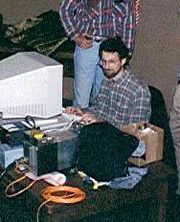
David L. Rabinowitz
Encyclopedia

Yale University
Yale University is a private, Ivy League university located in New Haven, Connecticut, United States. Founded in 1701 in the Colony of Connecticut, the university is the third-oldest institution of higher education in the United States...
. He has built CCD
Charge-coupled device
A charge-coupled device is a device for the movement of electrical charge, usually from within the device to an area where the charge can be manipulated, for example conversion into a digital value. This is achieved by "shifting" the signals between stages within the device one at a time...
cameras and software for the detection of near-Earth asteroids and Kuiper Belt Objects, and his research has helped reduce the assumed number of near-Earth asteroids by half, from 1,000-2,000 to 500-1,000 He has also assisted in the detection of distant solar system objects, supernova
Supernova
A supernova is a stellar explosion that is more energetic than a nova. It is pronounced with the plural supernovae or supernovas. Supernovae are extremely luminous and cause a burst of radiation that often briefly outshines an entire galaxy, before fading from view over several weeks or months...
e, and quasar
Quasar
A quasi-stellar radio source is a very energetic and distant active galactic nucleus. Quasars are extremely luminous and were first identified as being high redshift sources of electromagnetic energy, including radio waves and visible light, that were point-like, similar to stars, rather than...
s, thereby helping to understand the origin and evolution of the solar system
Solar System
The Solar System consists of the Sun and the astronomical objects gravitationally bound in orbit around it, all of which formed from the collapse of a giant molecular cloud approximately 4.6 billion years ago. The vast majority of the system's mass is in the Sun...
and the dark energy
Dark energy
In physical cosmology, astronomy and celestial mechanics, dark energy is a hypothetical form of energy that permeates all of space and tends to accelerate the expansion of the universe. Dark energy is the most accepted theory to explain recent observations that the universe appears to be expanding...
driving the accelerated expansion of the universe.
Collaborating with Michael E. Brown
Michael E. Brown
Michael E. Brown has been a professor of planetary astronomy at the California Institute of Technology since 2003....
and Chad Trujillo
Chad Trujillo
Chadwick A. "Chad" Trujillo is an astronomer and the co-discoverer of the dwarf planet Eris.Trujillo works with computer software and has examined the orbits of the numerous trans-Neptunian objects , which is the outer area of the solar system that he specialized in. In late August 2005, it was...
of the Quasar Equatorial Survey Team
Quasar Equatorial Survey Team
The Quasar Equatorial Survey Team is a joint venture between Yale University, Indiana University, and Centro de Investigaciones de Astronomia to photographically survey the sky. It uses the 48 inch The Quasar Equatorial Survey Team is a joint venture between Yale University, Indiana University,...
, he has participated in the discovery of several plutoids:
- 90377 Sedna90377 Sedna90377 Sedna is a trans-Neptunian object discovered in 2003, which was about three times as far from the Sun as Neptune. For most of its orbit it is even further from the Sun, with its aphelion estimated at 960 astronomical units , making it one of the most distant known objects in the Solar System...
, possibly the first known inner Oort cloudOort cloudThe Oort cloud , or the Öpik–Oort cloud , is a hypothesized spherical cloud of comets which may lie roughly 50,000 AU, or nearly a light-year, from the Sun. This places the cloud at nearly a quarter of the distance to Proxima Centauri, the nearest star to the Sun...
object. - 90482 Orcus90482 Orcus90482 Orcus is a trans-Neptunian object in the Kuiper belt with a large moon. It was discovered on February 17, 2004 by Michael Brown of Caltech, Chad Trujillo of the Gemini Observatory, and David Rabinowitz of Yale University. Precovery images as early as November 8, 1951 were later identified...
- ErisEris (dwarf planet)Eris, formal designation 136199 Eris, is the most massive known dwarf planet in the Solar System and the ninth most massive body known to orbit the Sun directly...
, more massive than PlutoPlutoPluto, formal designation 134340 Pluto, is the second-most-massive known dwarf planet in the Solar System and the tenth-most-massive body observed directly orbiting the Sun...
.
although he would not get credit for Haumea.
Together with Tom Gehrels
Tom Gehrels
Tom Gehrels , was an American astronomer, Professor Planetary Sciences, and Astronomer at the University of Arizona, Tucson....
of the University of Arizona
University of Arizona
The University of Arizona is a land-grant and space-grant public institution of higher education and research located in Tucson, Arizona, United States. The University of Arizona was the first university in the state of Arizona, founded in 1885...
and his Spacewatch
Spacewatch
Spacewatch is a project at the University of Arizona led by Robert S. McMillan that specializes in the study of minor planets, including various types of asteroids and comets...
Team, Rabinowitz discovered or co-discovered other astronomical object
Astronomical object
Astronomical objects or celestial objects are naturally occurring physical entities, associations or structures that current science has demonstrated to exist in the observable universe. The term astronomical object is sometimes used interchangeably with astronomical body...
s including:
- 5145 Pholus5145 Pholus5145 Pholus is a centaur in an eccentric orbit, with a perihelion less than Saturn's and aphelion greater than Neptune's. Pholus has not come within one astronomical unit of a planet since 764 BC, and will not until 5290. It is believed that Pholus originated as a Kuiper belt object.It was...
- 1991 BA

